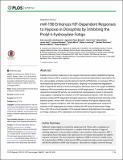| dc.contributor.author | De Lella Ezcurra, Ana Laura | en_US |
| dc.contributor.author | Bertolin, Agustina Paola | en_US |
| dc.contributor.author | Kim, Kevin | en_US |
| dc.contributor.author | Katz, Maximiliano Javier | en_US |
| dc.contributor.author | Gándara, Lautaro | en_US |
| dc.contributor.author | Misra, Tvisha | en_US |
| dc.contributor.author | Luschnig, Stefan | en_US |
| dc.contributor.author | Perrimon, Norbert | en_US |
| dc.contributor.author | Melani, Mariana | en_US |
| dc.contributor.author | Wappner, Pablo | en_US |
| dc.date.accessioned | 2016-07-14T19:17:05Z | |
| dc.date.issued | 2016 | en_US |
| dc.identifier.citation | De Lella Ezcurra, Ana Laura, Agustina Paola Bertolin, Kevin Kim, Maximiliano Javier Katz, Lautaro Gándara, Tvisha Misra, Stefan Luschnig, Norbert Perrimon, Mariana Melani, and Pablo Wappner. 2016. “miR-190 Enhances HIF-Dependent Responses to Hypoxia in Drosophila by Inhibiting the Prolyl-4-hydroxylase Fatiga.” PLoS Genetics 12 (5): e1006073. doi:10.1371/journal.pgen.1006073. http://dx.doi.org/10.1371/journal.pgen.1006073. | en |
| dc.identifier.issn | 1553-7390 | en |
| dc.identifier.uri | http://nrs.harvard.edu/urn-3:HUL.InstRepos:27662217 | |
| dc.description.abstract | Cellular and systemic responses to low oxygen levels are principally mediated by Hypoxia Inducible Factors (HIFs), a family of evolutionary conserved heterodimeric transcription factors, whose alpha- and beta-subunits belong to the bHLH-PAS family. In normoxia, HIFα is hydroxylated by specific prolyl-4-hydroxylases, targeting it for proteasomal degradation, while in hypoxia the activity of these hydroxylases decreases due to low oxygen availability, leading to HIFα accumulation and expression of HIF target genes. To identify microRNAs required for maximal HIF activity, we conducted an overexpression screen in Drosophila melanogaster, evaluating the induction of a HIF transcriptional reporter. miR-190 overexpression enhanced HIF-dependent biological responses, including terminal sprouting of the tracheal system, while in miR-190 loss of function embryos the hypoxic response was impaired. In hypoxic conditions, miR-190 expression was upregulated and required for induction of HIF target genes by directly inhibiting the HIF prolyl-4-hydroxylase Fatiga. Thus, miR-190 is a novel regulator of the hypoxia response that represses the oxygen sensor Fatiga, leading to HIFα stabilization and enhancement of hypoxic responses. | en |
| dc.language.iso | en_US | en |
| dc.publisher | Public Library of Science | en |
| dc.relation.isversionof | doi:10.1371/journal.pgen.1006073 | en |
| dc.relation.hasversion | http://www.ncbi.nlm.nih.gov/pmc/articles/PMC4880290/pdf/ | en |
| dash.license | LAA | en_US |
| dc.subject | Biology and life sciences | en |
| dc.subject | Genetics | en |
| dc.subject | Gene expression | en |
| dc.subject | Gene regulation | en |
| dc.subject | MicroRNAs | en |
| dc.subject | Biochemistry | en |
| dc.subject | Nucleic acids | en |
| dc.subject | RNA | en |
| dc.subject | Non-coding RNA | en |
| dc.subject | Biology and Life Sciences | en |
| dc.subject | Developmental Biology | en |
| dc.subject | Embryology | en |
| dc.subject | Embryos | en |
| dc.subject | Cell Biology | en |
| dc.subject | Hypoxia | en |
| dc.subject | Model Organisms | en |
| dc.subject | Animal Models | en |
| dc.subject | Drosophila Melanogaster | en |
| dc.subject | Organisms | en |
| dc.subject | Animals | en |
| dc.subject | Invertebrates | en |
| dc.subject | Arthropoda | en |
| dc.subject | Insects | en |
| dc.subject | Drosophila | en |
| dc.subject | Molecular Biology | en |
| dc.subject | Molecular Biology Techniques | en |
| dc.subject | Molecular Biology Assays and Analysis Techniques | en |
| dc.subject | Gene Expression and Vector Techniques | en |
| dc.subject | Hyperexpression Techniques | en |
| dc.subject | Epigenetics | en |
| dc.subject | RNA interference | en |
| dc.subject | Genetic interference | en |
| dc.subject | Metamorphosis | en |
| dc.subject | Larvae | en |
| dc.subject | Physical Sciences | en |
| dc.subject | Chemistry | en |
| dc.subject | Chemical Elements | en |
| dc.subject | Oxygen | en |
| dc.title | miR-190 Enhances HIF-Dependent Responses to Hypoxia in Drosophila by Inhibiting the Prolyl-4-hydroxylase Fatiga | en |
| dc.type | Journal Article | en_US |
| dc.description.version | Version of Record | en |
| dc.relation.journal | PLoS Genetics | en |
| dash.depositing.author | Kim, Kevin | en_US |
| dc.date.available | 2016-07-14T19:17:05Z | |
| dc.identifier.doi | 10.1371/journal.pgen.1006073 | * |
| dash.contributor.affiliated | Kim, Kevin | |
| dash.contributor.affiliated | Perrimon, Norbert | |


